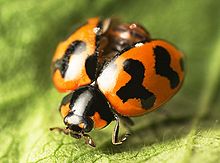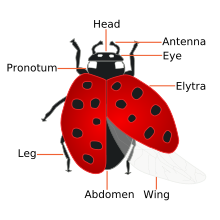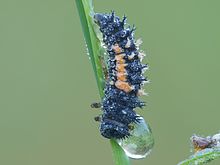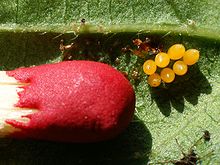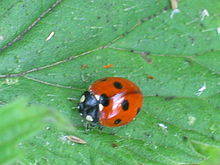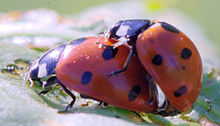- Coccinellidae
-
Coccinellidae 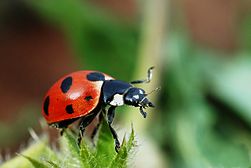
Coccinella magnifica Scientific classification Kingdom: Animalia Phylum: Arthropoda Class: Insecta Order: Coleoptera Suborder: Polyphaga Superfamily: Cucujoidea Family: Coccinellidae
Latreille, 1807 [1]Subfamilies - Chilocorinae
- Coccidulinae
- Coccinellinae
- Epilachninae
- Ortaliinae
- Scymninae
- Sticholotidinae
Coccinellidae is a family of beetles, known variously as ladybirds (UK, Ireland, Australia, Sri Lanka, Pakistan, South Africa, New Zealand, India, Malta, some parts of Canada and the US), or ladybugs (North America). Scientists increasingly prefer the names ladybird beetles or lady beetles[2] as these insects are not true bugs. Lesser-used names include God's cow, ladyclock, lady cow, and lady fly[3].
Coccinellids are small insects, ranging from 1 mm to 10 mm (0.04 to 0.4 inches), and are commonly yellow, orange, or scarlet with small black spots on their wing covers, with black legs, head and antennae. A very large number of coccinellid species are mostly, or entirely, black, grey, or brown and may be difficult for non-entomologists to recognize as coccinellids. Conversely, many small beetles are easily mistaken for coccinellids, such as the tortoise beetles.
Coccinellids are found worldwide, with over 5,000 species described,[4] more than 450 native to North America alone.
A few species are considered pests in North America and Europe, but they are generally considered useful insects, as many species feed on aphids or scale insects, which are pests in gardens, agricultural fields, orchards, and similar places. Harmonia axyridis (or the harlequin ladybug) was introduced into North America from Asia in 1916 to control aphids, but is now the most common species as it is out-competing many of the native species.[5] It has since spread to much of western Europe, reaching the UK in 2004.[5][6]
A common myth is that the number of spots on the insect's back indicates its age.[7][8]
Contents
Etymology
The name "ladybird" originated in Britain where the insects became known as "Our Lady's bird" or the "Lady beetle".[9][10] Mary (Our Lady) was often depicted wearing a red cloak in early paintings and the spots of the seven spot ladybird (the most common in Europe) were said to symbolise her seven joys and seven sorrows.[9] In the United States the name was adapted to "ladybug".
Common names in other European languages have the same association (the German name Marienkäfer translates to Marybeetle).[11]
The Dutch name "Lieveheersbeestje" and the colloquial French name "Bête à bon Dieu" mean "Our Lord's animal". The Irish name "Bóín Dé" means "God's little cow".
Biology
See also : List of Coccinellidae genera
Coccinellids are typically predators of Hemiptera such as aphids and scale insects, though larvae and eggs of their own species can also be important resources when alternative prey are scarce. Members of the subfamily Epilachninae are herbivores, and can be very destructive agricultural pests (e.g., the Mexican bean beetle). While predatory species are often used as biological control agents, introduced species of ladybirds (such as Harmonia axyridis or Coccinella septempunctata in North America) outcompete and displace native coccinellids and become pests in their own right.[citation needed]
Coccinellids are often brightly colored to ward away potential predators. This phenomenon is called aposematism and works because predators learn by experience to associate certain prey phenotypes with a bad taste (or worse). Mechanical stimulation (such as by predator attack) causes "reflex bleeding" in both larval and adult lady beetles, in which an alkaloid toxin is exuded through the joints of the exoskeleton, deterring feeding. Lady beetles, as well as other Coccinellids are known to spray a toxin that is venomous to certain mammals and other insects when threatened.[citation needed]
Most coccinellids overwinter as adults, aggregating on the south sides of large objects such as trees or houses during the winter months, dispersing in response to increasing day length in the spring.[12] In Harmonia axyridis, eggs hatch in 3–4 days from clutches numbering from a few to several dozen. Depending on resource availability, the larvae pass through four instars over 10–14 days, after which pupation occurs. After a teneral period of several days, the adults become reproductively active and are able to reproduce again, although they may become reproductively quiescent if eclosing late in the season. Total life span is 1–2 years on average.
It is thought that certain species of Coccinellids lay extra infertile eggs with the fertile eggs. These appear to provide a backup food source for the larvae when they hatch. The ratio of infertile to fertile eggs increases with scarcity of food at the time of egg laying.[13]
Habitats
Coccinellids are generally considered beneficial to gardeners, as they typically eat aphids, scale insects, mealybugs, and mites throughout the winter. As in many insects, ladybugs in temperate regions enter diapause during the winter, so they often are among the first insects to appear in the spring. Some species (e.g., Hippodamia convergens) gather into groups and move to higher land, such as a mountain, to enter diapause. Predatory ladybugs are usually found on plants where aphids or scale insects are, and they lay their eggs near their prey, to increase the likelihood the larvae will find the prey easily. Ladybugs are cosmopolitan in distribution, as are their prey.
Coccinellids also require a source of pollen for food and are attracted to specific types of plants. The most popular ones are any type of mustard plant, as well as other early blooming nectar and pollen sources, like buckwheat, coriander, red or crimson clover, and legumes like vetches, and also early aphid sources, such as bronze fennel, dill, coriander, caraway, angelica, tansy, yarrow, of the wild carrot family, Apiaceae. Other plants that also attract ladybugs include coreopsis, cosmos (especially the white ones), dandelions and scented geraniums.
Coccinellids are sensitive to most synthetic insecticides. If food sources are limited, oviposition is reduced. A larva uses its sharp jaws to crush an aphid's body and sucks out the aphid's juices.
Infestations
In the United States, Coccinellids usually begin to appear indoors in the fall. They leave their summer feeding sites in fields, forests and yards looking for a place to spend the winter. Typically when temperatures warm to the mid-60s Fahrenheit in the late afternoon, following a period of cooler weather, they will swarm onto or into buildings illuminated by the sun. Swarms of Coccinellids fly to buildings in September through November depending on location and weather conditions. Also, homes or buildings near fields or woods are more prone to infestation.[14]
The presence of Coccinellids in grape harvests can cause ladybird taint in wines produced from the grapes.
Impact on humans
After an abnormally long period of hot dry weather in the Summer of 1976 in the UK, there was a marked increase in the aphid population followed by a "plague" of Coccinellids, with many reports of people being bitten as the supply of aphids dwindled.[15][16] Recent studies suggest that Coccinellids can also cause allergic reactions, such as eye irritation or asthma.[17]
UK Ladybird survey
The ladybird atlas Ladybirds (Coccinellidae) of Britain and Ireland published in 2011[18] showed a decline of more than 20% in native species due to environmental changes and competition from foreign invaders. The distribution maps, compiled over a twenty year period with help from thousands of volunteers, showed a decline in the numbers of the common 10-spot and 14-spot ladybirds and a number of other species including the 11-spot, 22-spot, Cream-spot, Water and Hieroglyphic ladybirds, Coccidula rufa, Rhyzobius litura and Nephus redtenbacheri. Conversely, increases were seen in the numbers of Harlequin, Orange , Pine and 24-spot ladybirds as well as Rhyzobius chrysomeloides. The Kidney spot ladybird was recorded in Scotland for the fist time in recent years, probably due to climate change, and the once-extinct 13-spot was found to have recolonised Cornwall, Devon and the New forest. The most commonly recorded species was the 7-spot, closely followed by the Asian Harlequin — an invader that arrived from continental Europe in 2003 after being introduced to control pests. An 'explosion' in the number of Orange ladybirds, which feed on mildew, is thought to be due to the warmer damper conditions that now prevail in parts of England.[19]
In popular culture
Coccinellids are and have been for very many years a favorite insect of children. The insects had many regional names (now mostly disused) in English, such as the lady-cows, may-bug, golden-knop, golden-bugs (Suffolk); and variations on Bishop-Barnaby (Norfolk dialect) – Barnabee, Burnabee, the Bishop-that-burneth, and bishy bishy barnabee.[20] The etymology is unclear but it may be from St. Barnabas feast in June, when the insect appears or a corruption of "Bishop-that-burneth", from the fiery elytra of the beetles.[21]
The ladybird was immortalized in the still-popular children's nursery rhyme Ladybird, Ladybird:
Ladybird, ladybird, fly away home
Your house is on fire and your children are gone
All except one, and that's Little Anne
For she has crept under the warming pan.This poem has its counterpart in German as Marienwuermchen, collected in Des Knaben Wunderhorn, and set to music by Robert Schumann as Op. 79, No. 13.
Many cultures consider Coccinellids lucky and have nursery rhymes or local names for the insects that reflect this. For instance, the Turkish name for the insect is uğur böceği, literally meaning luck bug. In many countries, including Russia, Turkey, and Italy, the sight of a ladybug is either a call to make a wish or a sign that a wish will soon be granted.
In Christian areas, Coccinellids are often associated with the Virgin Mary and the name that the insect bears in the various languages of Europe corresponds to this. Though historically many European languages referenced Freyja, the fertility goddess of Norse mythology, in the names, the Virgin Mary has now largely supplanted her, so that, for example, freyjuhœna (Old Norse) and Frouehenge have been changed into marihøne (Norwegian) and Marienkäfer (German), which corresponds with Our Lady's Bird.[22] Sometimes, the insect is referred to as belonging directly to God (Irish bóín Dé, Romanian vaca-Domnului, Polish boża krówka, all meaning "God's [little] cow").[23] In Dutch it is called lieveheersbeestje, meaning "little animal of our Good Lord".
In both Hebrew and Yiddish, it is called "Moshe Rabbenu's (i.e. Moses's) little cow" or "little horse", apparently an adaptation from Slavic languages. Occasionally, it is called "Little Messiah".[24]
Some languages name the insect by its color. In Finnish, the Coccinellid is, for its blood red color, called leppäkerttu, translating to Blood Gertrud from the ancient Finnic meaning blood or the word leppä (that means alder in modern Finnish).[25]
In Roald Dahl's children's book James and the Giant Peach, The Ladybird, among a cast of anthropomorphic minibeast characters grown to human size, becomes perhaps the closest friend to the protagonist, James, treating him with motherly affection. In the American-produced 1996 animated film version, she was voiced by Jane Leeves and renamed The Ladybug, despite Leeves' northern English interpretation.
In the animated film A Bug's Life, Francis the Ladybug (voiced by Dennis Leary) is an aggressive Coccinellid and the clown in P.T. Flea's circus. The contrast between him being a male and a 'lady'bug is a recurring joke in the film.
As a logo
The ladybird street tile is a symbol against "senseless violence" in The Netherlands and is often placed on the sites of deadly crimes
Bold colors and simple shape have led to use as a logo for a wide range of organizations and companies including:
- Symbol of the Dutch Foundation Against Senseless Violence[26]
- Ladybird Books (owned by Pearson PLC)
- Ladybird range of children's clothing sold by Woolworths.co.uk and formerly by the (now defunct) Woolworth's chain store in the UK
- Polish supermarket chain Biedronka
- Atmel AVR Studio software logo
- Estonian mobile operator EMT[27]
- Software development firm Axosoft.
- Symbol of the Finnish Swedish People's Party.
In addition, it has been chosen as
- State insect of: Delaware, Massachusetts, New Hampshire, New York, Ohio, and Tennessee, though only New York has selected a species native to the United States (Coccinella novemnotata); the other states have all adopted an invasive European species (Coccinella septempunctata).
- An "official national mascot"[28] for Alpha Sigma Alpha, a national sorority in the United States.
References
- ^ "Chrysomelidae". Integrated Taxonomic Information System. http://www.itis.gov/servlet/SingleRpt/SingleRpt?search_topic=TSN&search_value=114509.
- ^ White, R.E. 1983. A field guide to the beetles of North America. Peterson Field Guide Series #29.
- ^ Definition of lady cow, Webster's Revised Unabridged Dictionary (1913), provided by die.net. Retrieved 14 November 2008.
- ^ Judy Allen & Tudor Humphries (2000). Are You A Ladybug?, Kingfisher, p. 30
- ^ a b Anon (5 October 2004). "'Deadly ladybird' sighted in UK". BBC News (BBC). http://news.bbc.co.uk/1/hi/england/essex/3715120.stm. Retrieved 17 June 2010.
- ^ Anon. "The Harlequin Ladybird has landed!". The Harlequin ladybird survey. http://www.harlequin-survey.org/. Retrieved 17 June 2010.
- ^ "Everything Ladybug! The source for Ladybug Stuff!". Everything-ladybug.com. http://everything-ladybug.com/ladybug-spots.html. Retrieved 2010-06-22.
- ^ Anon. "Ladybird spotters". UK Ladybird survey. http://www.ladybird-survey.org/lots_about.aspx. Retrieved 17 June 2010.
- ^ a b Anon. "Why are ladybirds so-called?". UK Ladybird survey. http://www.ladybird-survey.org/lots_about.aspx. Retrieved 15 October 2010.
- ^ Samaha, John M.. "Marian Roots of the Name". Our Lady's Bug. Dayton, Ohio: International Marian Research Institute. http://campus.udayton.edu/mary/questions/yq/ladybug.html. Retrieved 15 October 2010.
- ^ Anon. "common name: ladybirds, ladybird beetles, lady beetles, ladybugs (of Florida)". Featured creatures. University of Florida. http://entnemdept.ufl.edu/creatures/beneficial/lady_beetles.htm. Retrieved 8 April 2010.
- ^ A. Honek, Z. Martinkova & S. Pekar (2007). "Aggregation characteristics of three species of Coccinellidae (Coleoptera) at hibernation sites". European Journal of Entomology 104 (1): 51–56. http://www.eje.cz/pdfarticles/1197/eje_104_1_051_Honek.pdf.
- ^ J. Perry & B. Roitberg (2005). "Ladybird mothers mitigate offspring starvation risk by laying trophic eggs". Behavioral Ecology and Sociobiology 58 (6): 578–586. doi:10.1007/s00265-005-0947-1.
- ^ University of Kentucky-College of Agriculture Cooperative Extension Service
- ^ Anon (5 July 2001). "Phew, what a scorcher!". The Northern Echo. Newsquest media Group. http://archive.thenorthernecho.co.uk/2001/7/5/166513.html. Retrieved 8 April 2010.
- ^ Wainright, Martin (17 May 2006). "The great drought". THe Guardian (London: Guardian News and Media Limited). http://www.guardian.co.uk/environment/2006/may/17/water.ethicalliving. Retrieved 8 April 2010.
- ^ DMinSite, a division of Lagniappe Marketing. "Do Ladybugs BITE? And How Can You Keep Them Out of the House?". Gardensalive.com. http://www.gardensalive.com/article.asp?ai=649. Retrieved 2010-06-22.
- ^ Roy, Helen; Peter Brown, Robert Frost, Remy Poland (15 June 2011). Ladybirds (Coccinellidae) of Britain and Ireland. The Field Studies Council. pp. 204. ISBN 9781906698201.
- ^ Sample, Ian (15 June 2011). "Spot check finds Britain's native ladybirds struggling to compete with alien invaders". The Guardian (Guardian Newspapers ltd.): pp. 3. http://www.guardian.co.uk/environment/2011/jun/15/british-ladybird-species-struggling. Retrieved 17 June 2011.
- ^ Timmins, Nicholas (14 October 1994). "The Tories in Bournemouth: Teachers promised support as Shephard calls truce". The Independent (London). http://www.independent.co.uk/news/uk/the-tories-in-bournemouth-teachers-promised-support-as-shephard-calls-truce-1442798.html.
- ^ Lewie C. Roache (1960) Ladybug, Ladybug: What's in a Name? The Coleopterists Bulletin 14(1):21-25.
- ^ "Bishop Barnaby". Notes and Queries 9. 1849-12-29. http://www.gutenberg.org/files/13521/13521-h/13521-h.htm#page132.
- ^ [1][dead link]
- ^ Born to Kvetch, Michael Wex, St. Martin's Press, New York, 2005, ISBN 0-312-30741-1.
- ^ Hendrik Relve (1997), Puiden juurilla, Gummerus Kirjapaino Oy, ISBN 951-796-070-0, p. 38.
- ^ Anon (April 2004). "Speech by Mrs Maud de Boer-Buquicchio on the occasion of the placement of a ladybird tile at the Council of Europe". Council of Europe. http://www.coe.int/t/e/com/files/pa-sessions/april-2004/disc-coccinelle.asp. Retrieved 21 September 2011.
- ^ "Parima kvaliteediga kõned". emt.ee. http://www.emt.ee. Retrieved 2010-06-22.
- ^ ASA.osdcms.com
External links
- The Lost Ladybug Project Ongoing North American Ladybeetle Survey and Citizen Science Project based at Cornell University - Submit Photos
- Ladybirds of Australia
- Harlequin Ladybird survey in the British Isles
- Biological control: Predators: Lady beetles Cornell University's Guide to natural enemies in North America
- Lady Beetles of Florida on the UF / IFAS Featured Creatures Web site
- Taiwanese site Images
Categories:- Coccinellidae
- Cucujoidea
- Biological pest control agents
Wikimedia Foundation. 2010.

